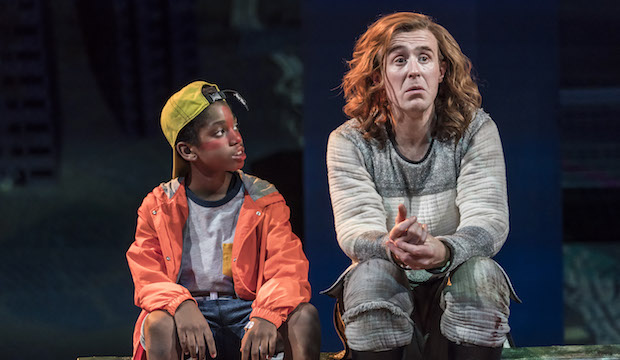
But Mullarkey’s narrative, divided into three distinct parts, falls short of the expected bar. In an ambitious attempt to tackle the root of all evil plaguing civilised society, the plot wanders with aimless direction, leaving the audience gasping for distraction.

Grace Saif (Healer's Daughter) in Saint George and the Dragon (c) Johan Persson
As we journey from the feudalist middle ages to modern-day disillusioned Britain via the Capitalist-riddeld Victorian Industrialist age, we see George, who becomes Saint George, fighting bravely for his people, freeing them from their oppressive ruler, the dragon.
In the beginning, the dragon is the three headed, fire-breathing dragon of popular folklore, but as the play unfolds, the mythical creature transforms into the totalitarian industrialist tyrant of Victorian England, and then, most jarringly, into us – the technology-loving, self-absorbed denizens of the modern world.
Symbolic of evil, greed and disillusionment – indeed all human sin – the metamorphosing dragon becomes harder and harder to kill. By the end of act one, George’s entirely successful ‘distract, stun, capture’ technique becomes utterly ineffectual. As society develops, the dragon, once an alien outsider becomes a familiar insider. His insidious menace infiltrates every porous crack of society's fragile blanket. He haunts us all and becomes inescapable.

Reuel Guzman (Boy) and Johan Heffernan (George) in Saint George and the Dragon (c) Johan Persson
Flashes of insightful brilliance punctuate this long meandering narrative. George’s first football game in a typical British boozer captures the fleeting commradery that unites a nation with poignant accuracy, while the slapstick buffoonery and reels of rhyming couplets add a touch of humour to a much-wearied plot.
The joyous highlight was George’s laboured 'Mega-bowl' gag (he attempts to swoon his fair maiden with a trip to the typically charmless bowling alley), which triggered a burst of raucous laughter from an-otherwise unengaged audience.
In fact, Johan Heffernan, who plays George, is the play’s saving grace. The ease with which he conveys George's radiating optimism lightens the predictable and repetitive narrative, which sees his character disappear to join the brotherhood and reappear to save ‘his native land’ again and again.
With an uninspired stage-set, underdeveloped stock characters and cheap-looking stage effects, George and the Dragon has a distinctly amateur feel about it.
The age old phrase, less is more, seems fittingly apt here.
| What | Saint George and the Dragon review, National Theatre |
| Where | National Theatre, South Bank, London, SE1 9PX | MAP |
| Nearest tube | Waterloo (underground) |
| When |
04 Oct 17 – 02 Dec 17, 7:30 PM – 10:00 PM |
| Price | £15 - £65 |
| Website | Click here to book now |

![Hair the Musical, The Vaults review [STAR:3]](/images/thumbs/cw-20850-660x375.jpg)

